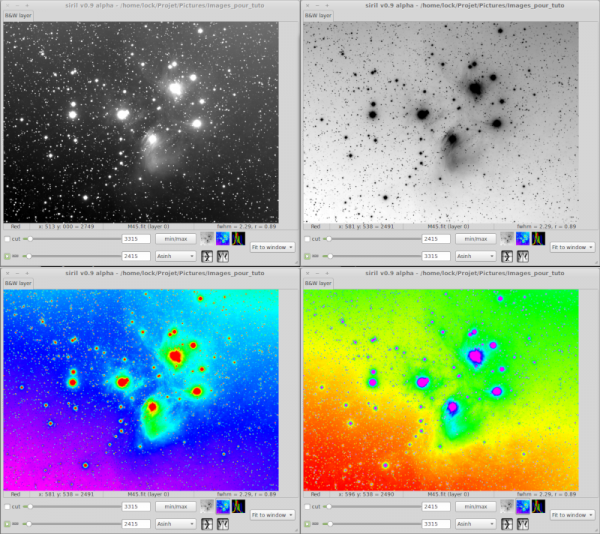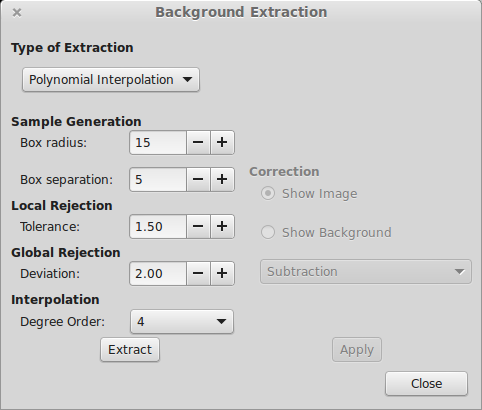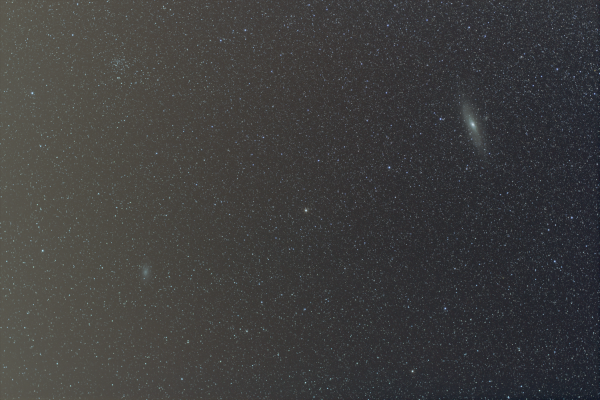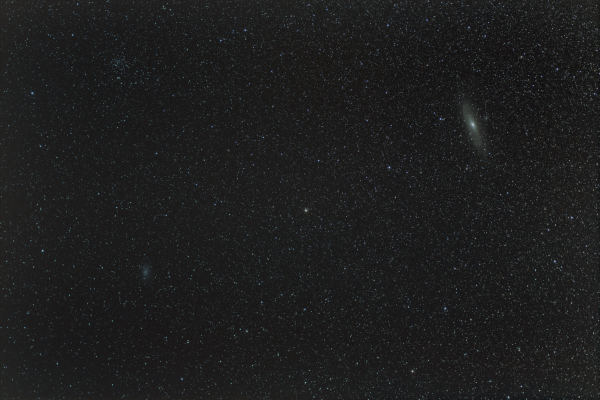No edit summary |
|||
| Line 56: | Line 56: | ||
==RGB Compositing== | ==RGB Compositing== | ||
A new channel synthesis tool is provided in Siril. This tool allows you to mix and align up to 7 channels plus one for Luminance. The tool handles the binning, just make sure to not crop the picture before: the bin1x1 must ALWAYS be loaded first and the bin2x2 pictures must be four times as small (divided by a factor of two in each dimension). | A new channel synthesis tool is provided in Siril. This tool allows you to mix and align up to 7 channels plus one for Luminance. The tool handles the binning, just make sure to not crop the picture before: the bin1x1 must ALWAYS be loaded first and the bin2x2 pictures must be four times as small (divided by a factor of two in each dimension). | ||
The first video shows a mixing between L, R, G and B channels with same size and no alignments needed | The first video shows a mixing between L, R, G and B channels with same size and no alignments needed: the L channel is given by an H-alpha processed image. | ||
This second video shows mixing between images with different binning. The alignment is also required. After mixing, save your picture and process it as you want. | This second video shows mixing between images with different binning. The alignment is also required. | ||
After mixing, save your picture and process it as you want. | |||
<html5media width="750">http://free-astro.vinvin.tf/videos/RGB_compositing.webm</html5media> | <html5media width="750">http://free-astro.vinvin.tf/videos/RGB_compositing.webm</html5media> | ||
Revision as of 19:22, 6 August 2014
Manual page for Siril
Siril is an astronomical image processing free software, see main page for more details.
A powerful astronomical image viewer
A Display Mode viewer is used to improve the visibility of an image, but without altering its pixel data in any way.
- Linear: This is the default mode in Siril. Pixels are displayed from the darkest to the brightest in a linear scale.
- Logarithm: Same than linear instead that here the scale is logarithmic. The operation emphase simultenaously information in faint and bright levels of the image.
- Square root: This transformation, takes the square root of each pixels. The result is close to the logarithm mode.
- Squared: Same than before but using the squared of each pixels.
- Asinh: The inverse hyperbolic sine is the most commonly used, it reproduces the perceptual ability of the human eye, which can accommodate to perceive dramatically different levels of brightness simultaneously. Asinh is close to the logarithm mode but has a better behavior around zero.
- Histogram: This mode increases the contrast of the image by increasing the dynamic range of intensity given to pixels with the most probable intensity values. It is very valuable to evaluate all the signal contained in the image.
All these modes can also be applied on each layer in an independent way.
This video tutorial shows the different modes you can use to display your images.
<html5media width="750">http://free-astro.vinvin.tf/videos/Display.webm</html5media>
In addition to this, Siril provides different colormap display:

Process your single images
Background extraction
When your image contains an intense light pollution, it is useful to remove it. Siril provides a "Background Extraction" tool in order to remove the gradient of the sky background. So far, Siril uses a polynomial method where generally 3rd degree is a good choice. However, this tool allows you to choose between first and 4th degree.
After extraction you can switch between image and background view in order to check the result. If you are satisfied you can thus apply the subtraction. This subtraction operation is very different from the simple operation used for the darks and bias/offsets. Indeed, as the level of the background is identical to the one of the image, applying a simple subtraction would result in a image with a lot of black pixels. To avoid any inconvenience, the operation is done with 32bits signed integers and finally converted into native format (16-bits unsigned).
Another tool is associated with Background Extraction : Sky Equalization. By clicking on Equalize, Siril will put the RGB values of the background to an homogeneous value; it is generally 10% of the total dynamic (you can controle it). For example, it corresponds on a 8-bit image, at a level of 30 / 255.
Following, respectively, the start image and final image (after background extraction and equalization):
- Another example of the "Equalize" function
<html5media width="750">http://free-astro.vinvin.tf/videos/EqualizeCP.webm</html5media>
Reducing green tint in processed images
This video tutorial shows how to remove the green tint in processed images using the graphical user interface. This function can also be accessed from the command line, with the rmgreen command.
<html5media width="750">http://free-astro.vinvin.tf/videos/RemoveGreen.webm</html5media>
Fast Fourier Transform (FFT)
A FFT algorithm is integrated to Siril in order to provide you a tool to evaluate fixed pattern noise of an image. You can thus remove the frequency pattern of the noise in the modulus file and save the result. Modulus and phase are saved in different files so you can compute the inverse transformation to retrieve the corrected image.
<html5media width="750">http://free-astro.vinvin.tf/videos/FFT.webm</html5media>
RGB Compositing
A new channel synthesis tool is provided in Siril. This tool allows you to mix and align up to 7 channels plus one for Luminance. The tool handles the binning, just make sure to not crop the picture before: the bin1x1 must ALWAYS be loaded first and the bin2x2 pictures must be four times as small (divided by a factor of two in each dimension). The first video shows a mixing between L, R, G and B channels with same size and no alignments needed: the L channel is given by an H-alpha processed image. This second video shows mixing between images with different binning. The alignment is also required. After mixing, save your picture and process it as you want.
<html5media width="750">http://free-astro.vinvin.tf/videos/RGB_compositing.webm</html5media>
<html5media width="750">http://free-astro.vinvin.tf/videos/RGB_compositing2.webm</html5media>
Tutorial for a complete sequence processing
An illustrated tutorial has been compiled to describe the usual processing steps, starting from RAW DSLR images to stacking.
- Convert your images in the FITS format Siril uses (image import)
- Work on a sequence of converted images
- Pre-processing images
- Registration (PSF image alignment)
- Stacking
A video tutorial is also available to describe the usual planetary processing.
<html5media width="750">http://free-astro.vinvin.tf/videos/mars_processing.webm</html5media>
Astrometry
Siril provides a few astrometry tools.
In particular, the PSF function that uses the Levenberg–Marquardt algorithm for minimization. See the dedicated page for a video tutorial.


